A day tour in North Norfolk today. Thankfully the overnight rain cleared through early and there was no sign of any of the forecast heavy showers – after some early high cloud, we had a lovely bright and sunny day, although with still a slight chill to the light NE wind. Lovely weather to be out birding.
Our destination for the morning was Cley. We parked by Walsey Hills and was we got out of the minibus, we could see a few Curlews and Redshanks on the grazing marshes opposite. A small group of Common Pochard were on Snipe’s Marsh and as we walked over to the East Bank they flew past us and landed again on Don’s Pool. A male Marsh Harrier was quartering out over the reedbed.
We stopped to listen and could hear several Sedge Warblers singing. One flew across the bank and landed in the reeds the other side of the path, where we could get it in the scopes briefly. Three Lapwings were chasing round over the grazing marshes and one of the males started displaying, flying swiftly back and forth and tumbling through the air, singing, before chasing the other male off over the reeds.

With one eye behind us, we noticed a Spoonbill circling above the trees. It kept disappearing behind the tops and then appeared to go down, but after a short while it was up again. As it came round we had a great view of its bill from below and eventually it turned and headed out across the reedbed towards the main scrapes.
A little further up, we could just hear a Reed Warbler singing its metronomic song over the louder, more buzzing Sedge Warblers. A Bearded Tit dropped in out of view in the reeds at the back and a short while later came up again, pinging, and disappeared away over the reedbed. We could see its long tail as it skimmed away over the tops of the reeds. A Little Grebe was diving in the edge of the pool below us.
As we continued on up the path, a Cetti’s Warbler shouted at us from the reeds on the far side of the ditch, but remained rather elusive at first. We had a couple of typical glimpses as it zipped through the reeds before it landed in the base of a small sallow and climbed up into the lower branches. Remarkably it stayed in full view, singing on and off, while we got it in the scope – a rare treat indeed for what is normally such a skulking species. Another Sedge Warbler was singing here, from the top of a small elder in the reeds, and we had much longer view of it, admiring its orange/red gape as it pelted out its song.
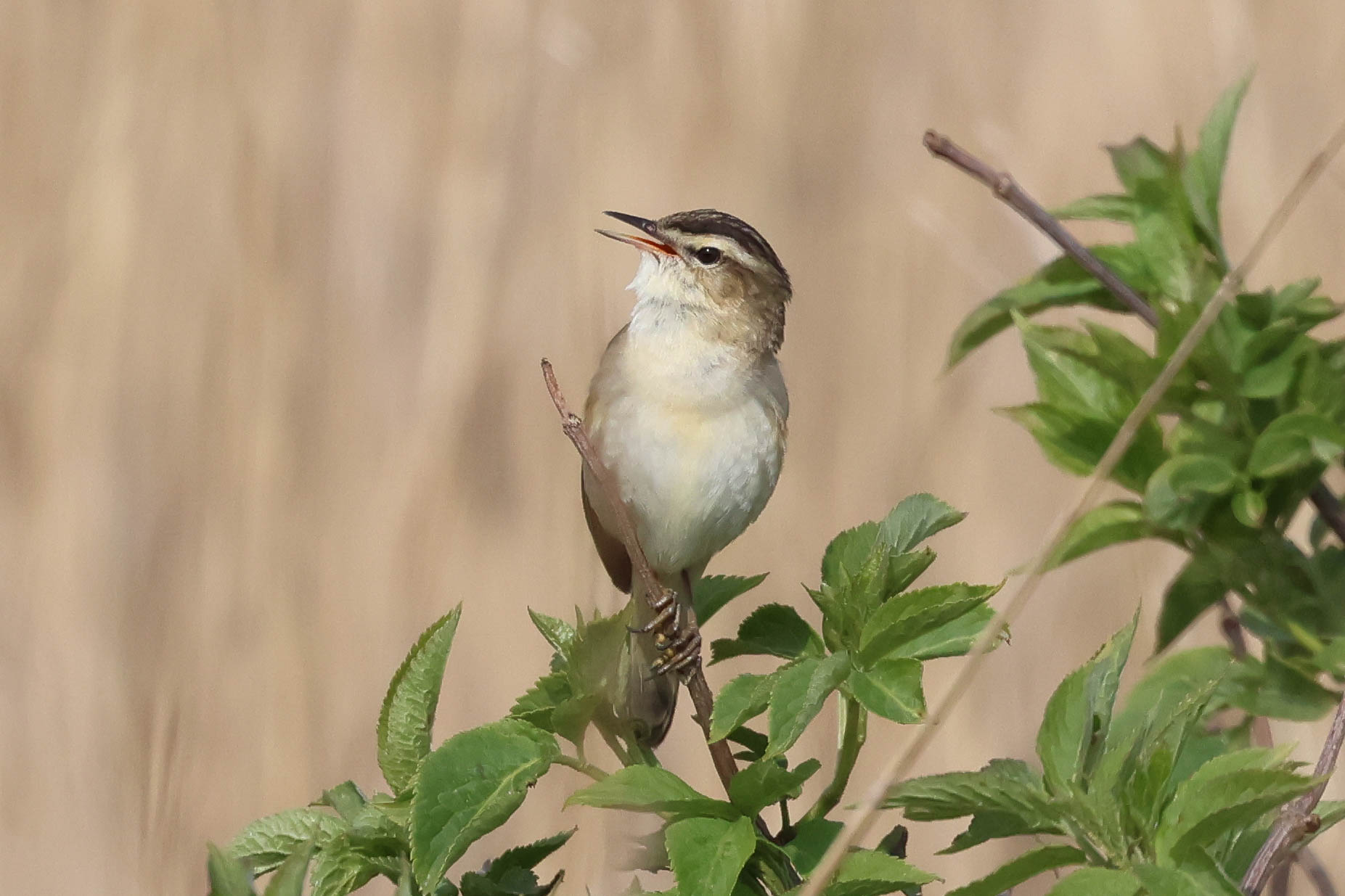
There are fewer ducks on the grazing marshes now, with more birds having departed for their northern and eastern breeding grounds in recent weeks. There were still a few Shoveler loafing on the back of the Serpentine and a small number of Teal and Gadwall. One male Marsh Harrier was still circling out over the reedbed behind us while another male flew in over the Serpentine, scattering all the ducks, before carrying on over the bank in front of us and out over the reeds the other side.
We stopped to admire a very smart rusty breeding plumage Black-tailed Godwit feeding on its own down at the front – there were several more out here but the others were right at the back on Pope’s Pool. A single Ruff was picking around on the mud, starting to moult into its more patterned summer body plumage but still too early for it to get its ruff. The distinctive calls of a Mediterranean Gull alerted us to its approach and we watched it being chased round over the Serpentine by a Black-headed Gull, before disappearing off towards the Brackish Pools, a 2nd summer with black spots in its wingtips.
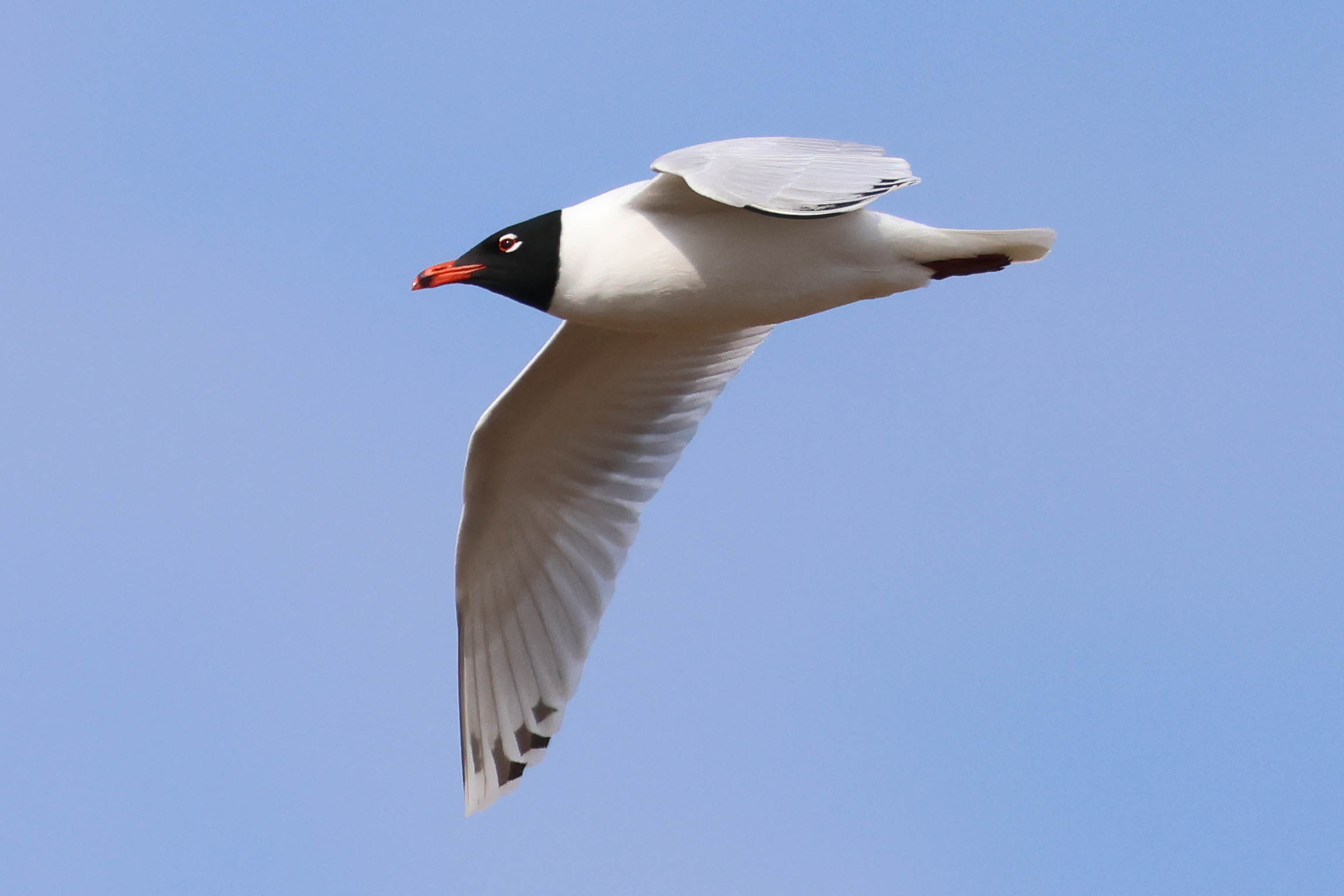
A little further on, we heard Bearded Tits pinging again and saw one drop down out of the reeds ahead of us towards the ditch just by the bank. We hurried up to where it had gone down and eventually found it, a male, picking along the base of the reeds on the other side of the ditch. It was hard to follow in all the reeds and eventually it flew up and disappeared off back over the tops. A couple of Reed Buntings were feeding on the path and another male was in the reeds by the ditch as we continued on towards Arnold’s Marsh.
There were lots of Dunlin and Redshank on Arnold’s Marsh, plus one or two Oystercatchers and a pair of Ringed Plovers on the shingle island at the back and a third which appeared out of the saltmarsh much closer to us. A quick scan of the Brackish Pools revealed six Pintail, including several very smart drakes upending and showing off their long, pin-shaped tails. A pair of Teal were down on the pools nearest the path, the drake dozing in the grass while the female fed in the water nearby.
A pair of Linnet were feeding on the path on the way to the beach, the male just starting to turn pinky-red on its breast. We stopped to admire a Meadow Pipit which was preening on a fence post and then it flew across and landed on the sign at the end of the East Bank. A male Reed Bunting perched obligingly on one of the fence posts too.
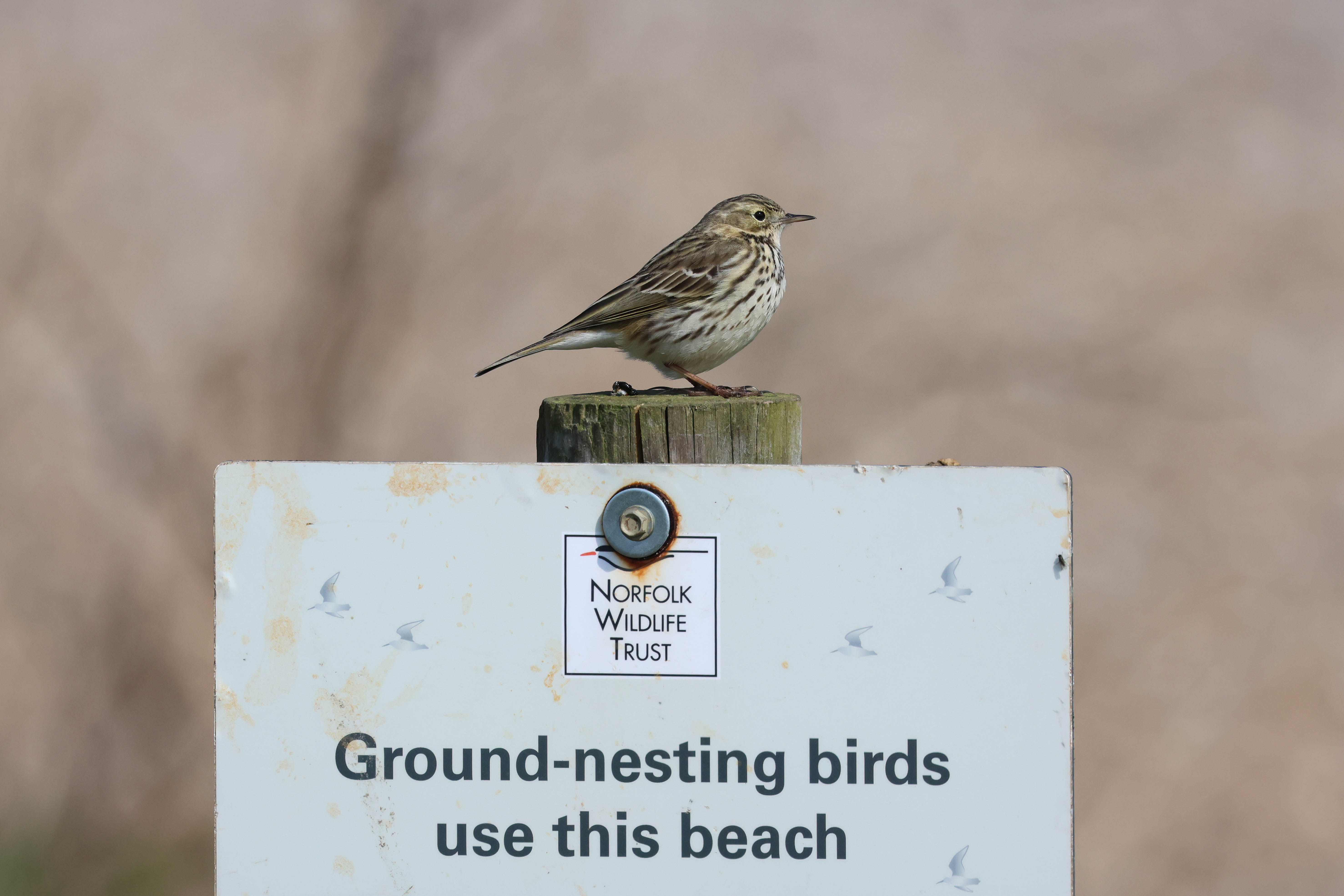
There was rather a distinct lack of birds moving along the coast this morning, possibly as a result of the cooler NE breeze, but we did pick up our first Swallow of the day now, as it flew in over the Brackish Pools, and we watched as it disappeared off on its way east.
A quick look out to sea from the beach didn’t reveal anything offshore today and all we could see along the remains of the old shingle ridge to the east were more Meadow Pipits and Linnets. We decided to head back. The 2nd summer Mediterranean Gull was back on the brackish pools now, hassling any of the Black-headed Gulls which were in easy reach. Past the main drain, we heard Bearded Tits again and looked over to see a pair flying in. They dropped down by the ditch below the bank and we had some great views of them now, a pair, as they fed low down in the reeds just above the water.
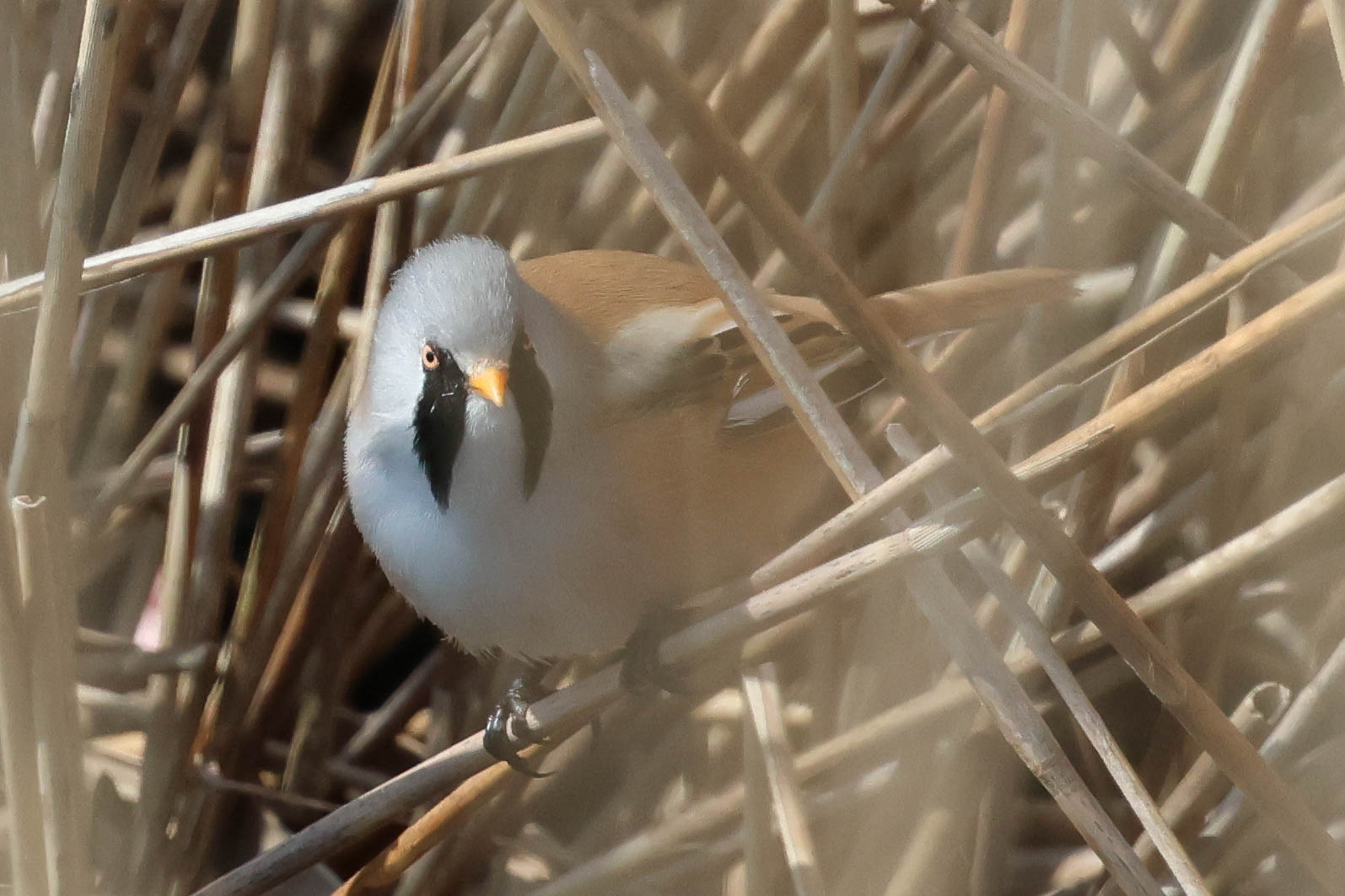
We stopped to admire the group of Common Pochard on Don’s Pool now, looking very smart in the sunshine, the drakes with their bright rusty heads and red eyes. Two Spoonbills flew back from the main scrapes and across the reedbed, disappearing behind the trees.
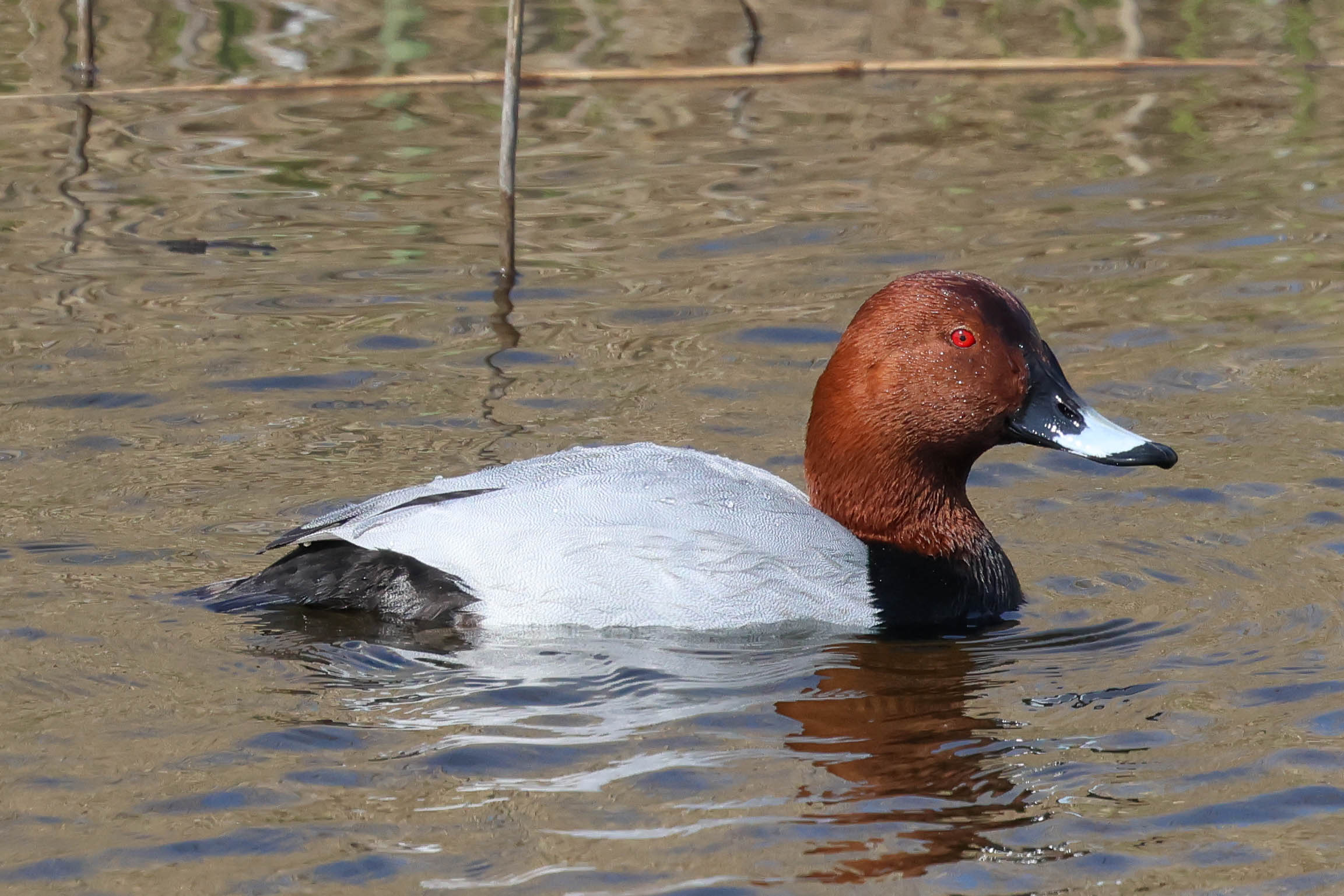
We still had a little bit of time before lunch, so we drove round to Coastguards for a quick look in Eye Field. A couple of Kestrels were perched on the telegraph posts along Beach Road as we passed and a couple of Ruff were on the pool just before the car park. As we got out of the minibus, a Skylark was singing overhead and several more Meadow Pipits chased round over the grass.
Scanning the Eye Field, we quickly located a Wheatear on the grass among the molehills. There was a bit of heat haze from where we were, so we walked a short way down over the shingle until we were directly opposite. We had a better view of the Wheatear from here through the scope, a smart male with black bandit mask and wings, grey back and rich burnt orange on the throat. Nice to catch up with a spring migrant, stopping off here to feed on its way north. There were a couple of Avocets on the small pool here, plus a pair of Shelducks and another Ruff.
We drove back round to the Visitor Centre for lunch. From the picnic area, we had a great view out across Pat’s Pool and we could see a couple of Spoonbills feeding in the water at the back. A Dunnock was singing in one of the small bushes by the picnic tables and a Blackbird flew across and landed on the hedge. As we were packing up, a Goldfinch landed in the bush right in front of us – stunning in the sunshine.
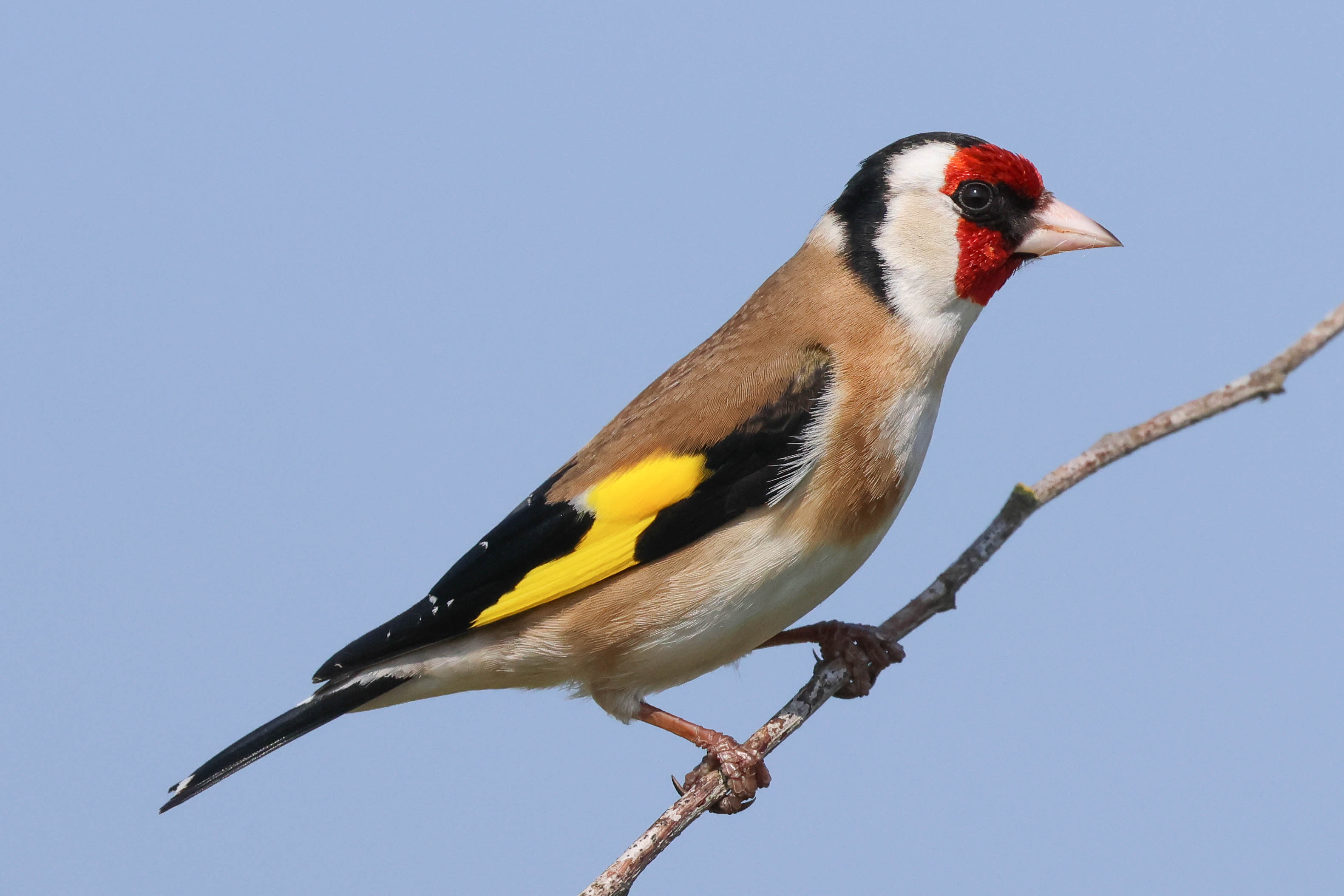
Having sorted out permits, we made our way out to the central hides. As we walked along the Skirts path, we could hear Mediterranean Gulls calling from the field across the road which was just being cultivated, and a 1st summer flew back over and past us, towards the scrapes. Along the boardwalk, we could hear Bearded Tits pinging from deep in the reeds and more Sedge Warblers singing.
We could see two Spoonbills on Whitwell Scrape from the boardwalk, so we went into Avocet Hide first. They were feeding at the back, sweeping their bills from side to side in the shallow water. We had just got them in the scope, when they took off and disappeared off west. Very unhelpful!
We scanned across to Simmond’s Scrape from here. There were lots of Black-tailed Godwits, many in rich rusty breeding plumage now, feeding in the water or roosting on the islands. Scanning carefully round the edges, we picked out a couple of Common Snipe in the reeds along the edge. One walked up onto the bank and a little later it reappeared feeding on a patch of wet grass with a Black-tailed Godwit. A Little Ringed Plover we lurking on a muddy spit in the back corner.

There was no sign of the Long-billed Dowitcher in any of its favoured haunts, but it had been on Pat’s Pool earlier this morning, so we walked round to Teal Hide next. There were several more Ruff on here, and a little group of Dunlin asleep on the front edge of one of the islands. A pair of Wigeon were an addition to the day’s list – numbers have dropped sharply in the last couple of weeks as wintering birds have departed. Looking through the gulls, we found four Mediterranean Gulls including the 1st summer we had seen on the way out and a couple of adult Lesser Black-backed Gulls dropped in.
We figured the Dowitcher might be hiding somewhere on Simmond’s Scrape, possibly asleep, so we headed back round to Daukes Hide for another look from there. There were several of the locals in the hide, and they hadn’t seen it. Something spooked all the godwits from the island where they were sleeping and there was no sign of anything with them (it turned out the Dowitcher was probably feeding elsewhere, because it flew back in later in the evening apparently). We decided to walk back.
As we got back to the Skirts path, we noticed a message about a Night Heron which had just been found by the Glaven River between Cley and Wiveton. As it was so close, we decided to go for a look and we thought it would be best to go straight away, before it got too busy. As we pulled up by the bridge, we got a thumbs up from someone just walking back so we piled out. We had expected the Night Heron to be roosting in the trees somewhere, so we were surprised to find it dozing on a patch of cut reeds right out in the open on the edge of the river directly below the bridge!
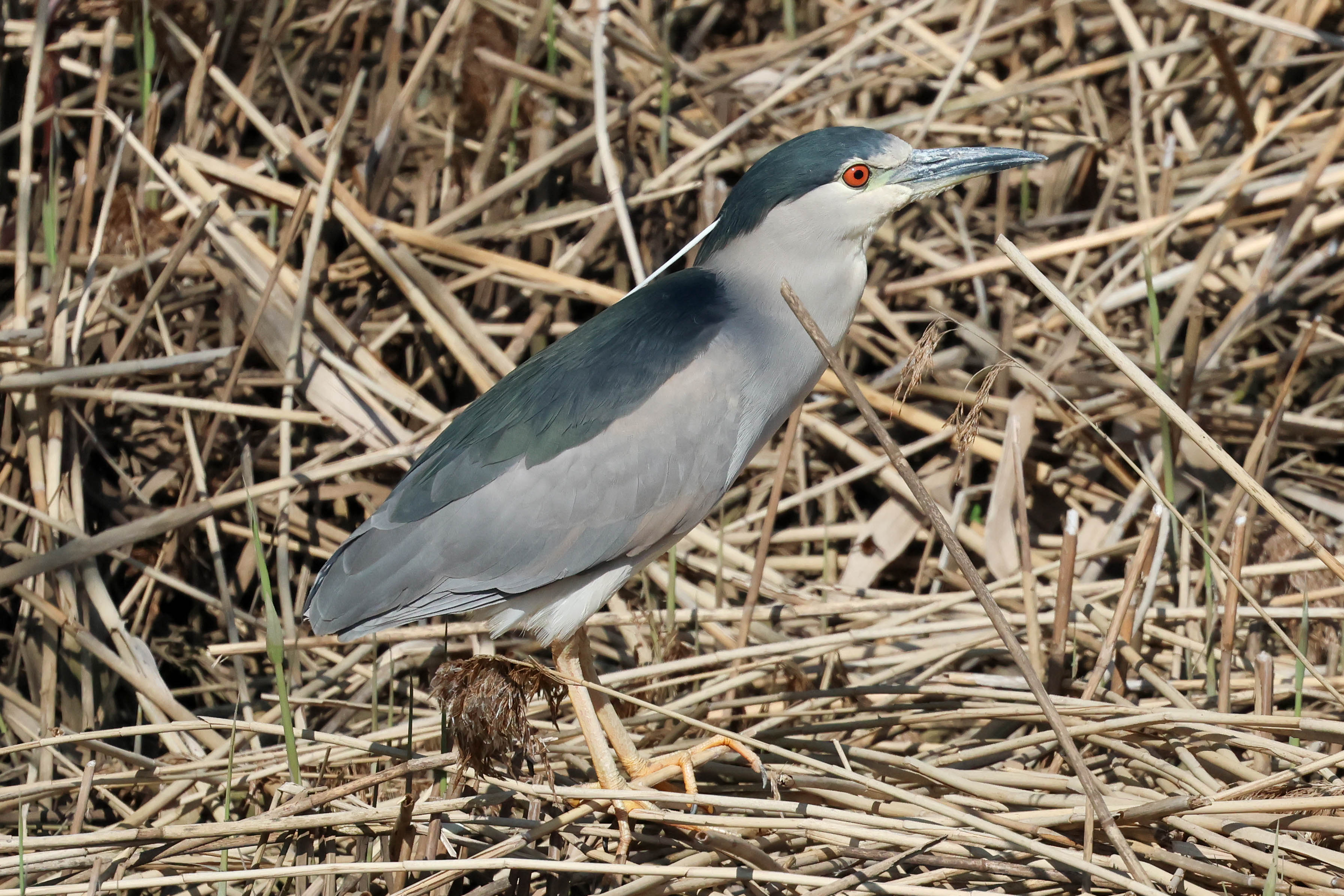
No need for a scope, it was too close. We stood on the bridge and watched it. After a few minutes the Night Heron woke up and turned round, giving us a much better view of its black crown with two long white plumes extending down over its back, and its bright red eye. Then for no apparent reason it took off. It disappeared behind the trees, then turned and flew over the road before dropping back down towards the river further south across the marshes. Lucky we had come straight away!
After our impromptu diversion to Wiveton, we drove back round to Kelling now. As we walked down the lane, we heard a couple of Blackcaps singing in the hedges and our first Chaffinch of the day. A couple of Chiffchaffs chiffed and chaffed and one flicked between the bushes. A couple of Blue Tits and a Long-tailed Tit flew across the path ahead of us.
Down at the gate, we stopped to scan the Water Meadow. A pair of Egyptian Geese were dozing in the grass, with a Pheasant and a pair of Red-legged Partridges just behind. There were lots of Brown Hares sunning themselves on the slope beyond, a quick count got to at least seventeen of them.
Down at the pool, a group of Sand Martins and one or two Swallows were hawking over the path and out over the water. In the sunshine, it properly felt like spring with hirundines flying round over our heads. A pair of Pintail were out on the water, along with a Little Grebe.
Continuing on round towards the beach, there were several Linnets and a pair of Stonechats on the brambles. Turning up the permissive path towards the gun emplacements, we came across another Wheatear feeding on the short grass behind the beach, much closer than the one we had seen this morning at Cley, and another Stonechat on the fence behind the research station. Looking out to sea, we picked up three Common Scoter diving just offshore so we got them in the scope for a closer look, a female, a 1st summer and an adult drake.
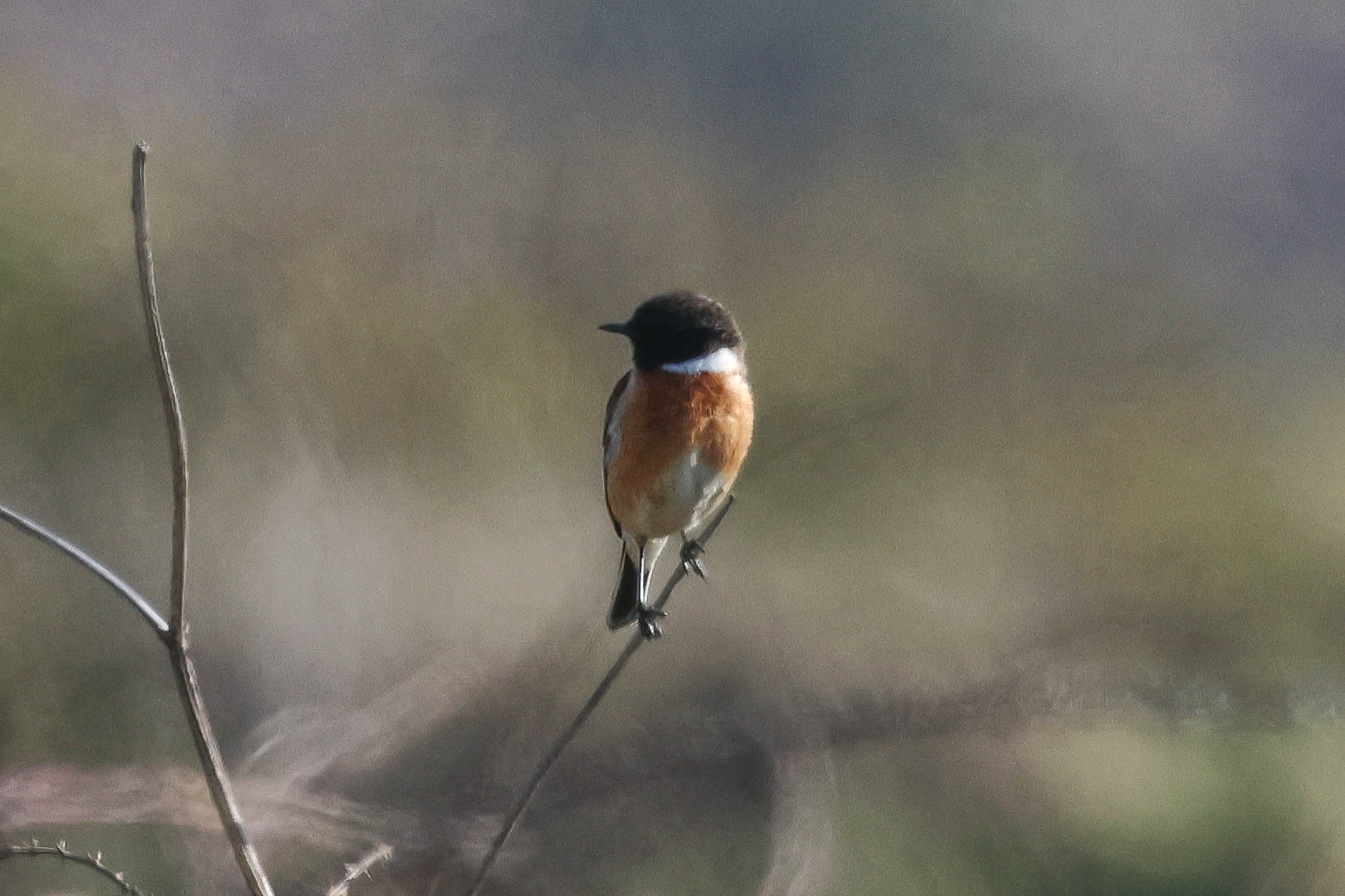
Unfortunately we were out of time and we had to head back. To underline the spring feel to the afternoon, a Speckled Wood butterfly flew past as we walked back past the Water Meadow, our first of the year. Summer is on its way!
















